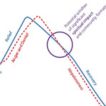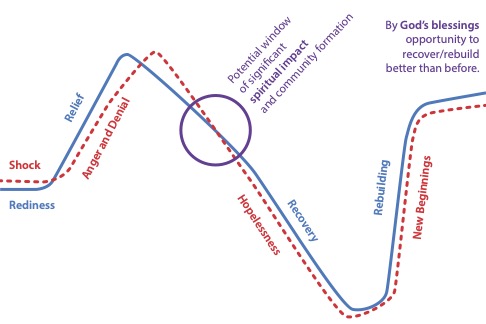Trauma Healing in Crisis Response

“Trauma is perhaps the greatest mission field of the 21st century.” —Diane Langberg, Suffering and the Heart of God
The word trauma has a variety of connotations in the West. However, much of the world does not have a word for it in their language, though they are not strangers to the concept and its effects. Trauma is “an emotional response to a stressful event or series of events that cause(s) a variety of negative consequences, including mental and emotional difficulties, and sometimes physical symptoms.”1 A single event or a series of events can have the same physical, emotional, and mental impact.
According to the Trauma Healing Institute, trauma creates a barrier between people and their understanding of the Gospel. The physiological impact of trauma can hinder a person’s physical ability to hear and understand the Gospel unless a way is made for them to understand. But listening to their story can open up a way for the Gospel to travel in. However, trauma psychologist Diane Langberg notes that if people have been living with ongoing trauma, they need community before they can tell their individual stories.2
A crisis or disaster, whether man-made or natural, shakes up people’s existing community or exposes their lack of community. A crisis also becomes a season where people hunger for community in ways they never have before. That hunger can be met at the deepest levels through healthy community. We define healthy community as small groups of ordinary disciples who love God, love others, and make disciples, pointing them to Jesus.
Many psychologists have observed3 that the majority of people who have experienced trauma do not need professional counseling but rather need a healthy community. Christian trauma-healing practitioners would say that community needs to be centered around God’s Word and listening well. Though professional counseling can help for a season, it does not replace the lifelong need for community, for which God created us.
Ironically, a crisis can harm community at the very time when community is most needed. From Bible times to the present, we have seen God at work during times of crisis in and through healthy community. For example, as the Muslim call to prayer sounded through the window last month, several ladies in the Middle East sat on the floor, sharing about communities that had been created during a past disaster response, and how, years later, the groups still continue to multiply. After beginning with trauma healing a few years ago, the discipleship groups are now spreading into surrounding countries. Their husbands, who are unbelievers and actively involved in Islamic leadership, have told them they will not allow their families to change locations because of the transformation they have seen in their wives as they participate in these healing communities.
How can we foster an environment of healthy community from the very moment a crisis occurs? Awareness of the average trauma-healing journey enables believers to more effectively love and disciple those impacted by trauma. As we disciple those impacted by trauma, they learn to walk alongside others who are hurting. Learning this skill also builds resilience in their own lives. Ultimately, this kind of discipleship plants emotionally healthy seeds in new disciples, ensuring that good things multiply (like healing) rather than bad things (like the effects of unresolved trauma).

More information on application of this graph can be found in the P.R.E.P.A.R.E. article.
In the phase of acute or event-based disaster response, we can layer the average physical and emotional timelines with potential spiritual windows. Keep in mind that every person follows this sequence at their own pace. Timelines and rate of healing are often highly influenced by the existing community (or lack thereof), past trauma, and physical environment.
Physical relief often parallels the average timeline of the first emotional phase of anger and denial. As physical relief dissipates, emotional processing frequently shifts to hopelessness. Eventually, over time, people begin to rebuild both physically and emotionally. They experience “new beginnings.” As people impacted by disaster experience the overlap of these two timelines, we see perhaps one of the greatest windows God has given us to love and build community among people receptive to Bible stories, leading them to Jesus. This window occurs as people slide into the stage of hopelessness, as relief efforts wane and non-profits leave the site. If we reach people in this window and facilitate healthy community, the “new beginnings” they experience as they rebuild physically and emotionally tend to be stronger than even before the disaster.
As people slide into the stage of hopelessness, they crave the community we’ve described. If we, during that season, give them an opportunity to experience community that facilitates physical, emotional, and spiritual healing (in a context centered around God’s Word), we also have facilitated a contagious environment. We see this described in Acts 2:42–47, as disciples met together during the difficult circumstances of their lives. Their activities of helping each other physically, teaching, and fellowshipping together created a community to which each day the Lord added to their fellowship those who were being saved.
If we read Scripture through the lens of crisis and trauma,4 we note that in Acts 4, Peter and John experienced a crisis of getting thrown in jail. As soon as they were free, they went back to their community and shared their experience.
The community listened, was strengthened, and spoke God’s Word with boldness and love. We, as ordinary disciples and churches, can respond to crises as the Church in Acts did.
How do we facilitate the kind of community that responds well to crisis? By facilitating the essential foundations for any healing: community, faith, and purpose. These are needed in the journey of walking people through the stages of healing as outlined above.
The first step in healing is creating a loving and healthy community through listening. We can listen by asking three significant questions to help people process, either one-on-one or in small groups:
1. What happened?
2. How did you feel?
3. What was the hardest part? [or the best part?]
The second step in healing is establishing faith, based on a relationship with God and His Word. These same listening questions can be used to guide healthy lamenting with the Lord, sharing with Him, as the ultimate listener, the responses to the questions. We can then close with a statement of who God is in the midst, “I believe [or I want to believe] that you are [insert truth from Scripture].” Examples of lament in the Bible include Psalms 6, 22, 38, 44, 60, and 130. Stories from God’s Word provide the foundation for lament and learning. Because trauma impacts the brain in ways that make it difficult for people to interact with written text, oral stories, and activities centered on the truth and healing of God’s Word play a critical role in healing.
The third step, purpose, is foundational for creating a “contagious” environment. People find purpose when they understand that they also can share the healing and truth they have found through God’s Word.
As they experience healing through listening and loving each other (healing community), deepening their faith in God (faith), and intentionally sharing God’s Word with others (purpose), they form a strong, multiplying group. Such a group can sustain itself through the joys of “new beginnings,” and weather the next crisis that comes their way.
As the Middle Eastern women previously mentioned sat on the floor eating together, they reminded each other of the storms they had weathered together. One member of their group had died. Another woman’s family had experienced kidnapping in their home country. Another had experienced abuse. But the community remained strong. The women talked about how they had seen God’s grace and faithfulness through the way the community remained united through every hardship. This community, which began out of a momentary crisis, has remained strong three years later, consistently growing in number and in depth of relationship with Jesus.
These ladies remember well the vision of simple trauma-healing groups. Could we come to see things the way Joseph did, who said to those who had hurt him: Do not be afraid. You meant to harm me, but God used what has happened for good–not just for me–but so that many other people could be saved (from Gen. 50:20)?
Resources: www.GodinCrisis.vision/articles www.MultiplyingHope.org









comments